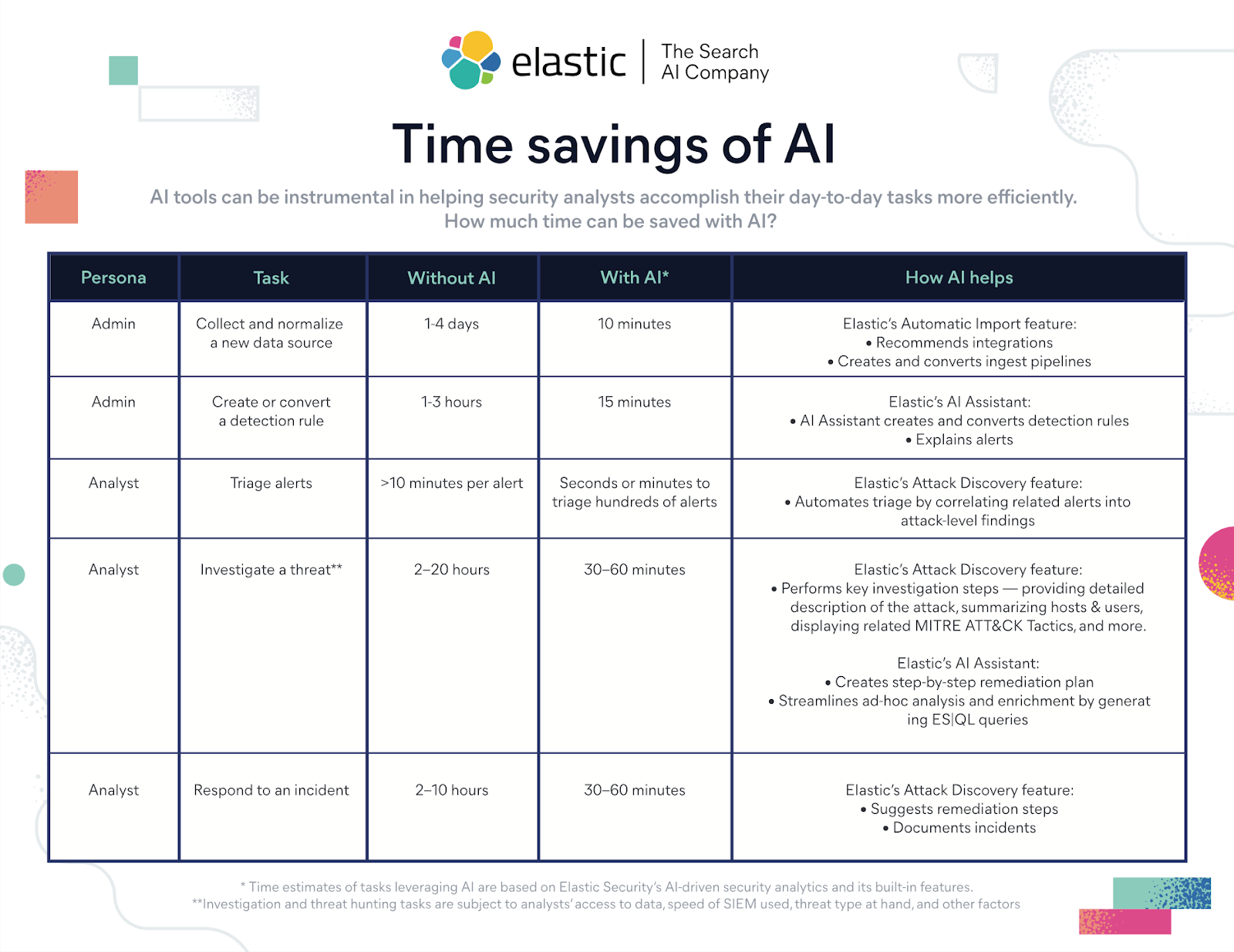9 benefits of AI-driven SIEM for boosting security

AI-driven security information and event management (SIEM) solutions equip practitioners to work far more efficiently and effectively than traditional SIEM solutions, which rely on manual processes for configuring data ingestion, triaging alerts, and creating incident response playbooks (to name a few).
The most advanced of this new era of SIEM tools use generative AI (GenAI) to streamline practitioner workflows. These capabilities assist analysts and administrators alike with the ability to distill attacks from a deluge of alerts, guide remediation, and even ease the process of migrating SIEMs.
AI-driven SIEM solutions thereby automate and simplify processes that have (until now) remained complex and time-consuming — providing an accurate picture of risk and significantly enhancing the efficiency and effectiveness of the SOC.
Let’s dive into the top nine benefits of an AI-driven SIEM in terms of both business value and cybersecurity preparedness.
1. Enhanced threat detection and response
AI-driven SIEM solutions analyze vast amounts of data in real time to identify potential threats — continuously learning and adapting to the evolving cybersecurity landscape to uncover unknown threats.
They’re especially effective against advanced persistent threats (APTs). Combing through real-time and historical data, they can apply both advanced analytics and sophisticated analysis of alerts to find APTs in the earliest stages of an attack. That’s almost impossible for security teams to achieve at scale using traditional analytical methods.
Such efficiency is vital for mitigating the impact of today’s cybersecurity incidents. Once AI detects a threat, it can automate a predetermined response process, fire alerts to your team, implement predefined response actions, or orchestrate a complex response workflow tailored to the specific threat type.
2. Real-time monitoring
Achieving visibility across your attack surface is a critical yet difficult and error-prone process. In fact, the complexity of expanding visibility on legacy SIEM tools has long kept many organizations flying blind and often tied to outdated technologies. Organizations need a tool that provides the ability to continuously monitor the security-relevant resources in your environment, including your cloud applications and infrastructure, user authentication and activity records, server and endpoints, network data, security alerts, and more.
An AI-driven SIEM streamlines your primary data ingestion tasks, including data collection and normalization (yes, even custom data sources). In fact, modern SIEM systems use GenAI to onboard custom data in minutes, slashing the time needed to migrate from a legacy solution to an AI-driven SIEM. It can also help admins enrich data — both automatically and on an ad hoc basis — to provide access to valuable context like threat intelligence.
3. Streamlined compliance
AI-driven SIEMs simplify compliance by simplifying ingestion of custom data sources, including critical applications, systems, and infrastructure. They also guide the creation of saved searches, reports, and other compliance automation resources, helping the organization adhere to rules and standards for compliance monitoring and enforcement.
4. Improved alert accuracy
False positives bog down security teams working with traditional SIEM solutions. Instead of investigating real attacks, practitioners spend many working hours looking into and evaluating suspicious security events — many of which end up as false-positive or non-critical alerts.
AI-driven SIEMs, on the other hand, can accurately discern between actual threats and legitimate events that may be suspicious in appearance. By analyzing alerts holistically, applying the latest research from the threat landscape, and incorporating contextual data, modern SIEMs ensure that practitioners are focused on the attacks that really matter.
5. Automated incident management
Legacy SIEMs don’t do enough to help security teams with managing incidents as they lack comprehensive threat context, relevant insights, and tailored prescriptive guidance. These limitations make it challenging for teams to effectively detect, prioritize, and respond to incidents — resulting in slower response times and increased risk of missed threats.
AI-driven SIEMs can guide practitioners to triage, investigate, and respond to critical attacks by replacing tedious processes and enabling security teams to focus on the most critical, strategically demanding tasks. By offering a comprehensive view of incidents, modern solutions help security teams understand the full scope of an incident and work together to resolve it. And with access to tailored recommendations, SOC teams can make faster, more informed decisions.
6. Scalability
Modern AI-driven security analytics solutions are designed to easily scale to handle far more data than previously centralized in a SIEM. This scalability makes them well-suited to support organizations undergoing expansion and digital transformation.
7. Flexible deployment
The most enterprise-ready AI-driven SIEM solutions help your SOC adapt by offering multiple deployment models, such as on-premises, hybrid cloud, and multi-cloud, to suit your infrastructure needs and ensure robust protection across all your environments. Using the latest generation of model-agnostic SIEMs, you can change, add, or customize your deployment model to suit your evolving needs.
8. Reduced operational costs
Replacing manual data management, security monitoring, and incident handling with AI-driven processes saves time and resources and lowers operational costs.
By leveraging a modern SIEM solution, your security teams can focus on complex and critical threats, strategic analysis, and leave AI to wrangle data and mitigate alert fatigue.
9. Time savings
With less time spent on onboarding data, chasing false-positives, and figuring out next steps, your overall security stance improves. Here’s a look at exactly how an AI-driven SIEM saves your team time:

The future of security with AI-driven SIEM
Just as cyber threats are evolving quickly in the AI era, so too are AI-driven SIEMs. These solutions are helping SOCs efficiently address a wide range of use cases and are helping proactive defenses become more of a reality for organizations adopting AI.
See the difference an AI-driven SIEM can make for your team.
The release and timing of any features or functionality described in this post remain at Elastic's sole discretion. Any features or functionality not currently available may not be delivered on time or at all.
In this blog post, we may have used or referred to third party generative AI tools, which are owned and operated by their respective owners. Elastic does not have any control over the third party tools and we have no responsibility or liability for their content, operation or use, nor for any loss or damage that may arise from your use of such tools. Please exercise caution when using AI tools with personal, sensitive or confidential information. Any data you submit may be used for AI training or other purposes. There is no guarantee that information you provide will be kept secure or confidential. You should familiarize yourself with the privacy practices and terms of use of any generative AI tools prior to use.
Elastic, Elasticsearch, ESRE, Elasticsearch Relevance Engine and associated marks are trademarks, logos or registered trademarks of Elasticsearch N.V. in the United States and other countries. All other company and product names are trademarks, logos or registered trademarks of their respective owners.

